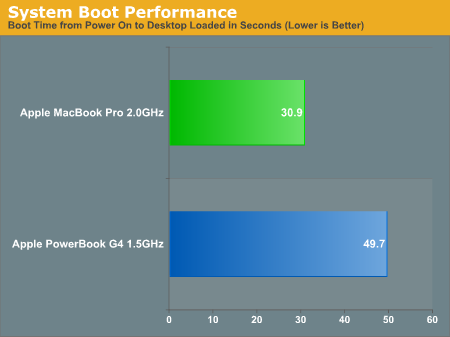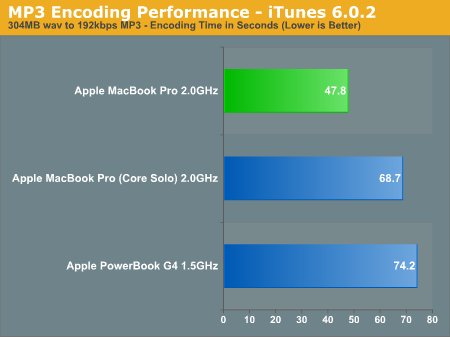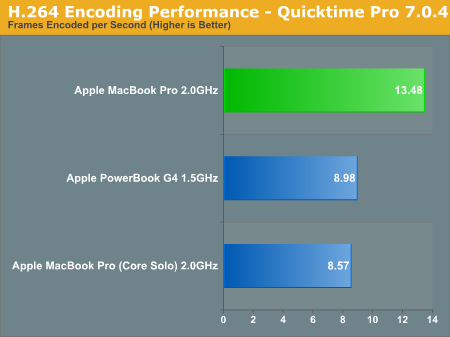Apple's MacBook Pro: Using it as a Mac and a PC
by Anand Lal Shimpi on April 13, 2006 12:00 AM EST- Posted in
- Mac
Performance Comparison: G4 vs. Core Duo
Before I get to the actual numbers comparing my PowerBook G4 1.5GHz to the MacBook Pro 2.0GHz, I should say that actually using the machine felt a lot faster. Just scrolling through a Finder window is so much faster on the MacBook Pro than on the old G4. Everything is a lot more responsive and the system as a whole feels desktop-fast. That being said, I can't get away without putting it to the test so here we have it - a PowerMac G4 1.5GHz vs. a MacBook Pro 2.0GHz.
Both systems are configured the way they were from Apple, with 1GB of memory but the original hard drives in each. Obviously the MacBook Pro has an advantage there because of its newer hard drive, however most of my tests aren't very disk bound minimizing the impact of differing hard drives. First off, we've got the good ol' boot test:

The MacBook Pro boots much quicker than the old PowerBook G4, much like the iMac Core Duo boots faster than the iMac G5. While the PowerBook G4 boots (from power on to desktop fully loaded) in just under 50 seconds, the MacBook Pro does it in just over 30 seconds. Although personally I keep my notebook on almost as much as my desktop, boot time is important for traveling where I'm constantly turning my machine on and off.
Just like in my iMac Core Duo review, wherever benchmarks/applications were multi-threaded I tried turning off the second core on the MacBook Pro to give you a good idea of what a Core Solo would be performing like up against the PowerBook G4. Not only is this interesting to look at, but there's also a good possibility that the future iBook replacement will have Core Solo as a processor option. The first two tests here both happen to be multi-threaded so you'll see results from both the Core Solo and Core Duo setups.

The MacBook Pro is ridiculously fast compared to the PowerBook G4 in converting MP3s using iTunes: the encode time is around 35% lower on the MacBook Pro. Disabling one of the cores does significantly level the playing field, although the Core Solo at 2.0GHz still manages to be a bit faster than the G4 1.5.

Under QuickTime we see a full 50% increase in performance over the PowerBook G4. If you disable the second core, the G4 1.5 actually pulls ahead of the Core Solo 2.0. The PowerBook to MacBook Pro upgrade, purely from a performance stance, is looking very impressive already.










52 Comments
View All Comments
mzlin - Saturday, April 15, 2006 - link
Excellent review, Anand! The Parallels vs Boot Camp comparisons are really well done and very helpful.I thought the comment about PowerBook weight being 1/3 more than any other laptop you've used was a little misleading. I'm sure you didn't mean to say the PowerBook was especially heavy, but since you didn't actually mention what it weighs (5.6 pounds), it could be construed as the Powerbook weighs 1/3 more than other 15.4-inch laptops.
I have been looking for 15.4-inch laptops, PC or Mac, that weigh less than 6 pounds with an integrated optical drive. (For me, having the drive integrated is non-negotiable; I wouldn't want to have it in the wrong place when I needed it, so I would be carrying it around regardless, and much better to save the hassle of digging it out and plugging it in when one needs it.) But the Powerbook/MacBook is the only one I have found so far. On the PC side, the VAIO BX and Toshiba Satellite A105 manage to get to 6.0 pounds, but are also are 1.5 inches thick.
hechacker1 - Saturday, April 15, 2006 - link
I'd just like to point out that the buzzing due to power state switching (transitioning between C3 and C4 states) also happens in windows and linux. It's purely a hardware issue, and in most cases it just means the manufacturer used low quality components (capacitors).In windows it is not as noticible because it runs with a kernel frequency of 100Hz. In linux it's often run with 1000Hz. Because of the increase in frequency of power state switching the buzzing becomes audible to the ear.
In windows it happens 10 times less than most linux boxes. Hence you don't hear it as much even with low quality components. My own Dell 700m laptop has this issue.
The only solution in linux is to disable the lower power states, or change the kernel timer to 100Hz like windows. The best solution is to use dynamic tick switching so you get exactly the responsiveness you need, only when you need it. With a patched linux kernel my laptop automatically goes to 54Hz when idle, and 1000Hz when under load.
Anyways... the only reason those "fixes" work is probably because they cause the processor to do just enough work to avoid having to go into the lowest power mode.
corequadro - Friday, April 14, 2006 - link
I found it as a perfect help against the annoying whine. Just start and then stopp it, and you will – if you aren't using ichat – have a perfectly silent macbook till the next reboot.Of course, a fix from Apple would be more effective, but I can live with the widget fix.
brich - Friday, April 14, 2006 - link
I really think the MacBooks have legs to grow, especially once the intel transition is completed over the next year and universal support becomes more 'universal.' My 12" PowerBook G4 1.5 has served me very well, even with the limitations of XP Pro running in VPC 7 inside Tiger. I think that some of the PC-only enthusiasts who add a MacBook to their arsenal will discover that the integration of excellent hardware esthetic and design with an OS that is continually developing/improving (OSX) will make the Mac solution quite compelling.That said, if I were a user who was totally satisfied with Windows and was not interested in OSX, then I would not buy a Mac to run Windows...no reason to do it. The real differentiation is the new flexibility of the intel Macs with OSX as a viable alternative to XP now and Vista later. Ther ability to run XP on them is frosting on the cake, imho.
ohnnyj - Friday, April 14, 2006 - link
Dear Apple,I want a 12in Merom MacBook.
Desslok - Thursday, April 13, 2006 - link
Acorrding to Daily Tech the hardware bugs you talked about are fixed with the new revs of the MacBook Pro. The article also stated that Apple would allow you to trade your MacBook in if you were having these problems.JAS - Thursday, April 13, 2006 - link
Tonight, I visited an Apple Store to see the MacBook Pro in person. What a gorgeous, well engineered laptop -- and impressively fast! The units on display did have rather warm undersides; but perhaps these are from the initial manufacturing run ("version A").trooper11 - Thursday, April 13, 2006 - link
Great job on the review, it was interesting to see how close things are coming on the software side to run a Windows environment on Macs and pointing out how similar Macs have gotten to every other laptop maker, at least in terms of parts and performance.The thing that gets me now is that the change over to Intel processors and ,in general, a more universal system, has made the Mac just another notebook vendor. So whst the Mac Book Pro has going for it is OS X and any of the Apple software, the machine itself is no better or worse then the many laptop manufacturers putting out Windows based pcs. In the past Macs had sort of mystique relating toa percieved uniqueness.
If everyone realizes this, then Id like to see a review of a Mac Book from the perspective of any normal system evaluation. Comparing the experience with Apple with those of HP, Dell, Acer, or even Lenovo. If Im not a fan of the Mac OS, then I dont see any other reason to pick them over say Acer or Lenovo. I certainly wouldnt pay a price premium for the Apple name unless I saw some first hand reviews relating to price/performance and quality of service you can expect.
anthlover - Thursday, April 13, 2006 - link
Those who have a powerbook that runds under 1ghz will be well served by the new books NOW. Those that have 1.5 and 1.67 have not need to quickly switch unless there is some native apps including apps free ones they want to use.Those that have no book will do well with them.
Waiting unless somthing new was coming out in a couple of weeks is silly. Computers and their prices change constantly, models are refreshed and replaced rapidly. One should always buy what they need and try to future proof too much.
Of course those wanting to save might want to wait for the Ibooks err Mac Book.
Glad to hear replacing the drive got **easier then on the earlier Alumibooks... Or at least the 12 inch one. I got through the keyboard replacement part of the disasemly I had done before and then read ahead to the upper case disassembly and realized that I need a brighter room, no cats trying to help, and a lot of care. Too much risk. With the books It sounds like when you want that 200gb 7200 rpm drive it will be easy to put in:)
plinden - Thursday, April 13, 2006 - link
The choppiness can be made almost unnoticeable by reducing the "Hardware acceleration" - Display Properties/Settings/Advanced/Troubleshooting, and move the slider one notch to the left.